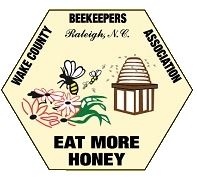 | Wake County Beekeepers Association |
Beekeeping Calendar
Nutrition
| January |
Ironwood or Coma bloom. Carefully check amount and location of honey stores, and feed May need dry sugar added if low on stores. Some natural pollen sources available. Bees may gather dry pollen substitute if offered. Add pollen supplements if desired to boost brood production. Once you start feeding, you may need to continue if natural pollen isn’t present due to brood buildup. |
| February |
Red Maples bloom 1st thru March 12th. (green pollen) Willow (yellow pollen) A colony rearing brood will consume about 10 pounds of food per week, a colony with small food reserves can starve during bad weather (below 15 pounds, start feeding honey or 1 to 1 sugar water or fondant or dry sugar. May need dry sugar added if low on stores. |
| March |
Sugar maples, dandelions (orange pollen), ornamentals, fruit trees, red bud will start blooming this month. The bees will continue to consume honey stores. They will also bring in a fair amount of pollen during this month. Feed 1 to 1 sugar water if starting new colonies or to boost small ones. Pay attention to long periods of wet cold weather. Colonies at risk of starvation or brood death if unable to bring in new nectar and pollen for large brood nests. |
| April |
Alsike Clover, Blackberries, Crimson Clover, Ladino (White Clover), Tulip Poplar (second half) of the month), Black Gum, Black Locust, Vetch, Holly, and Raspberries, will be blooming this month. Nectar flow is usually the heaviest this month. Monitor syrup consumption. Likely only needed to build comb for packages or when adding empty frames. May discontinue feeding if the syrup is ignored. |
| May |
Poison Ivy (orange pollen) to 5/23; Tulip Poplar to 5/26; Offer syrup to new package bees to build comb as long as they continue to use it. Set up water stations. |
| June |
Sumac to 6/12; Vitex about 6/10 - ; Clover Set up water stations. Pollen sources abundant, but nectar sources dwindle. Dearth begins the second half of June |
| July |
Clover to 7/25; Coreopsis, 7/25 – 10/8, Heartsease and Smartweed bloom this month. Keep water available constantly Pollen sources still available, almost no natural nectar sources in sufficient quantities to feed colonies with no honey stores. Will need feeding of syrup Nectar dearth in full swing |
| August |
Nectar dearth in many areas, may begin to ease late in the month Goldenrod, 8/1 – 10/15; Snowpeas before 8/14; Stickweed after 8/14 Feed 1 to 1 or maybe 2 to 1 sugar water Caution on feeding pollen because of abundant hive beetles. Do not over harvest Keep water available constantly |
| September |
Goldenrod 8/1 – 10/15; Coreopsis; Asters, 9/20 – 10/30. Fall nectar flow may take place Remember to leave at least 40 pounds of honey for the hive to get through the winter. Keep water available constantly Feeding continues until the bees will take no more syrup. Feed 2 to 1 sugar water Some large colonies will gain weight from fall nectar, but cannot be relied upon to build weight for winter. Check those that had good honey stores to ensure they didn’t burn through it. |
| October |
Goldenrod 8/1 – 10/15; Coreopsis; Asters, 9/20 – 10/30. Last reliable month to add weight to colony. Hive should be very heavy with cured honey. Feed 2 to 1 sugar water Natural pollen sources still available. |
| November |
Feed 2 to 1 sugar water or candy boards Only neglected colonies that weren’t fed earlier will NEED solid feed this early. Natural pollen sources still abundant. |
| December |
Feed 2 to 1 sugar water or candy boards Natural pollen still available to bees in our area. May need dry sugar or fondant added if low on stores. |
